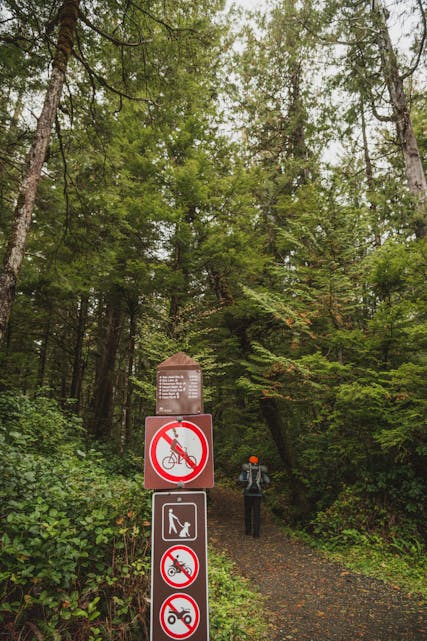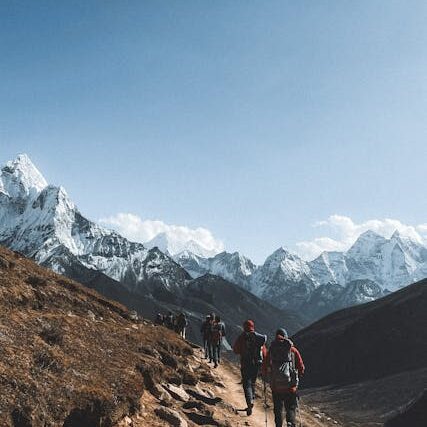
Today, I’m going to be talking about the finer aspects of hiking beyond just the physical journey. If you’re lacing up your boots and hitting the trails for the first time, know that hiking is more than a form of exercise; it’s a way to connect with nature and with others who share your path. But before you set out, you’re going to find out about the unwritten rules that govern the trails.
This isn’t just about knowing which snack to pack or how to find the best trail. More information on discovering the best trail is here. It’s also about understanding how your actions affect the environment and those around you. Hiking etiquette for beginners is the set of guidelines that harmonizes our love for adventure with respect for the natural world and our fellow trail enthusiasts. Think of it as a social contract that ensures a pleasant experience for everyone.
Leave No Trace Principles: Nothing In, Nothing Out
When we head out into nature, it’s not just about soaking in the beauty – it’s also about preserving it for others. Following the Leave No Trace principles ensures that everyone can enjoy the trail as much as you do. Here’s how to be a hiking hero:
- Pack it in pack it out: Imagine hiking up to a beautiful scenic overlook only to find it littered with snack wrappers and plastic bottles. Not cool, right? Whatever you bring with you on the trail – whether it’s an energy bar wrapper, a used tissue, or even biodegradable stuff like fruit peels – it all needs to come back out with you. Bring a small trash bag to stash your waste until you find a proper disposal spot. It’s simple: if it wasn’t there when you arrived, it shouldn’t be there when you leave!
- Take nothing out: Nature is full of treasures, from unique rocks to ancient trees and maybe even some cool old artifacts. It’s super tempting to take a little something home as a souvenir, but remember, these belong to the wilderness. Imagine if everyone took a rock from that beautiful creek – it wouldn’t take long for the creek to look pretty bare. Take photos, make memories, but leave everything else as you found it. That way, the magic of the place remains intact for the next hiker who comes along.
Trail Etiquette: Sharing the Path Responsibly
You’re going to find out about how to coexist peacefully with fellow hikers and nature. Think of the trail as a shared resource; a place where everyone has the right to enjoy a slice of the great outdoors.
- When to yield: When you’re out there, it’s crucial to know the unwritten rules of the road. Whether you’re ascending or descending, it’s good practice to yield to uphill hikers. They’re tackling gravity and might need that momentum to keep going.
- Mixed use trails: Mixed-use trails can be a bit trickier. Bikers, horseback riders, and walkers all share these routes. So here’s a simple rule of thumb: bikers yield to both hikers and horseback riders, and hikers yield to horses. Always stay alert and be ready to step aside.
- Trail markers and signs: Navigating trails means respecting the markers and signage. These are not mere decorations; they are crucial for preserving the environment and keeping everyone on the right path ether literally or figuratively.
- Stay on track: Yes, it’s tempting to create your own shortcut, but don’t. “Social trails,” the unofficial paths created by repeated walking, can cause erosion and damage plant life. Stick to the marked trails to help maintain the integrity of our beautiful natural landscapes.

Here’s something to remember: as you pass others, a quick ‘hello’ or a nod goes a long way in fostering a cooperative atmosphere. And if you’re stopping for a break, move to the side of the trail to let others pass seamlessly. Championing these simple practices keeps trails pleasant and ensures they last for generations.
Respecting Wildlife: Coexisting with Nature’s Inhabitants
You’re going to find out about something incredibly important now, and that’s how to respect the wildlife you’ll meet while hiking. I’m not just talking about the ‘oooh’s and ‘ahhh’s of spotting a deer – it goes deeper than that. We’re sharing their home, and it’s crucial we do this respectfully.
Here’s the deal: wildlife should be just that – wild. Our presence shouldn’t alter their natural behaviors. That means keeping a safe distance, never feeding animals (yes, that includes the seemingly harmless chipmunks), and of course, avoiding wildlife during sensitive times like mating, nesting, or when they have young with them.
Now, let’s say you round a bend and there’s a bear. It’s not the time for a selfie. Instead, know how to respond safely and responsibly. Each encounter can be different, so understand the guidelines for each species you might encounter.
The bottom line here is simple: our actions can have serious consequences on wildlife. By following best practices, you can minimize your impact and avoid contributing to habituation or stress. You don’t want to be the reason a bear learns that people mean food, which can lead to dangerous situations in the future.
Group Hiking Tips: Navigating the Social Trail
Have you ever thought about the dynamics of hiking with a group? It’s not just following a leader and hoping for the best. You’re going to find out about how to smoothly sail through the natural world arm-in-arm with your fellow trail enthusiasts.
- Single file: First up, hiking in a single file on narrow paths isn’t a conga line option – it’s a must. This respects the trail’s integrity and minimizes our impact on the surrounding vegetation.
- Waiting: Waiting at intersections for the whole group is crucial. It’s easy to take a wrong turn or lose someone, and that’s a problem we want to avoid. Not only does this ensure everyone’s accounted for, but it also ensures everyone can stay on the correct path together.
- Communicating with the group: Effective communication is key. It might feel unnecessary to check in with the person behind you, but trust me, it’s important. This isn’t just about staying in touch, it’s ensuring everyone’s comfort and safety. Keeping an eye on the people ahead and behind you makes sure the pace works for everyone and any assistance is offered when needed. If you have to wander off for a loo break or stop to tie a shoe lace, let the person in front know.
- Nominate a tail: Nominating an experienced hiker as the last person is a great way to ensure the safety of the group and prevents a slower hiker from getting left behind.

Safety Etiquette: Prioritizing Wellbeing on the Trails
When you’re out on the hiking trails, safety isn’t just a personal concern; it’s a communal responsibility. I’m going to explain why the collective aspect of safety is so crucial. Whether you’re trekking solo or with a group, your decisions have ripple effects on other hikers and rescue teams.
- Pre-trip planning: Choose something that resonates with you, whether it’s paper maps or a GPS app, and learn how to use them effectively. Research your hike, so you understand the distance, ascents and descents involved Remember, a well-planned hike includes informing someone about your route and expected return time.
- The right gear: This can make a difference between a memorable hike and a call for help. The right gear – like adequate water and food, a first-aid kit, appropriate footwear, warm and waterproof jacket and even a head lamp – is your first line of defense against the unpredictable elements of nature.
- First aid: In my opinion, there’s no over-emphasizing the importance of first aid knowledge. A twisted ankle or a sudden allergic reaction can turn critical if not addressed promptly. Learn the first aid appropriate to your environment. If walking in the summer where there can be snakes, brush up on how to treat a snake bite. Equip yourself with basic first aid skills – they’re priceless out there.

Don’t worry too much about becoming a wilderness expert overnight. What’s more important is the ability to recognize when a situation is beyond your skill set. This includes knowing emergency procedures and when to signal for help.
Now, this leads into how our ever-present devices fit into all of this – and it’s not just about taking a killer selfie at the summit. So here’s the scoop on integrating tech into your hiking while maintaining safety and respect for the environment.
Balancing Tech and Nature: Responsible Technology Use on Trails
We’re living in a digital age, and it’s not surprising you might want to bring your gadgets along on a hike. I’m going to talk about the interplay between technology and nature. You’re going to learn about maintaining a respectful balance that enhances your experience without detracting from the environment or others’ enjoyment.
So let’s face it, technology can be incredibly useful on the trail. Whether it’s GPS for navigation, a fitness tracker to log your journey, or a camera to capture the scenery, your devices can play a pivotal role. However, using these gadgets responsibly is key. Keep the volume down if you must listen to music or podcasts, and consider using one earphone so you can stay aware of your surroundings. Personally, I find the sounds of nature music to my ears.
And what about those times when safety is a concern? In my opinion, that’s when technology really shines. Apps can help you track your route, while a charged phone is crucial in case of an emergency call. A power bank is also useful to keep your battery charged. But remember, you don’t always need to have your tech on hand. Sometimes, it’s refreshing to disconnect and fully immerse yourself in the great outdoors.
Finally, think about your fellow hikers. Not everyone wants to hear your latest playlist or jump into your phone’s camera frame while on the trail. Choose something that resonates with everyone’s right to enjoy the tranquility of nature. It’s all about striking the right balance.
Conclusion: Stepping Forward with Respect and Awareness
I’ve walked you through the ropes of hiking etiquette, from the hallowed ‘Leave No Trace’ principles to sharing trails with wildlife and fellow humans. You’ve learned the basics of group dynamics, the need for safety, the balance of technology use, and, importantly, personal conduct that keeps the trails welcoming for everyone.
Remember, hiking isn’t just about conquering peaks or crossing miles; it’s about blending into the ecosystems you encounter and forging connections with nature and people. So next time you lace up those boots, you’re going to walk with a sense of environmental stewardship and communal respect that goes far beyond just enjoying the view.
Happy Hiking!
If you have comments or questions, I’d love to hear from you.

I like your ‘best trails’ link, and I feel that you should insert more links to get people to stay longer on your site. I’m so glad you are ethically strong in this article. Young people tend to leave garbage everywhere. I live in Japan, and Mount Fuji, our main mountain, is covered in plastic garbage that gets buried in bad weather. This is detrimental to the environment, as you know. I always carry a garbage bag wherever I go! And your rules for mixed trails are excellent. By the way, are these rules national – for your country – or international?
Hi Linden, That’s so dissappointing that people leave rubbish on Mount Fuji. I just don’t understand it. There are no written rules but most hikers would be considerate to those climbing up hill and let them pass first. Having to stop and stand on a slope is a little challenging. Plus they want to keep their momentum going. Though, I sure some hikes would relish the opportunity to take a break and let others pass.
Your article on hiking etiquette for beginners is good. I really appreciate how you covered the basics in such an easy-to-understand way. Your tip about yielding to uphill hikers is something I never thought about before—super helpful! Do you have any advice on how to handle encounters with wildlife on the trail? Your point about leaving no trace is so important. Do you have any favorite products or techniques for minimizing waste while hiking? Thanks for the great read and the helpful tips!
Bob,
Thanks. Firstly, be aware of what wildlife you may have an encounter with and research how to behave safely. As a general rule, stay calm and back away without making startling movements. Don’t make direct eye contact with an animal like a bear as they can take that as a direct challenge. Never approach baby animals as there will be a protective mother around.
In Australia we have to be careful of snakes in the summer, so I wear gaiters and have a snake bandage in my first aid kit. Watch where you sit, look out for ants nests, bull ant bites are painful. Learn how to deal with leeches or ticks. It’s about learning how to deal with the animals you may encounter.
Wow, your post is in-depth, I have never been on a hiking trip before but I have heard of persons who have but what you are sharing brings a fresh approach that one should do while going hiking. It is good to come across this guide that can help me and so many others. Thanks for sharing.
Norman,
You are welcome. Feel free to ask me questions if you have any.
Hi Lyn
I like that your article is a well-crafted and informative guide that will undoubtedly help new hikers feel more confident and prepared on the trails. It effectively covers essential aspects of trail etiquette, such as yielding the right of way, leaving no trace, and being mindful of noise levels. The tips are practical and easy to understand, making it a valuable resource for anyone new to hiking. The inclusion of reminders to respect wildlife and fellow hikers enhances the overall message of enjoying nature responsibly.
I remember my first hike, and honestly, I was pretty clueless about the unwritten rules. I accidentally blocked a trail while trying to take a selfie, and a friendly hiker had to politely let me know. The tips in this post are super practical—especially the advice about yielding to faster hikers and respecting wildlife.
Wow Lyn, just when I think I know everything about hiking, you pull off another great read! I must say, I was surprised to learn about yielding and right of way on the trail—I had always thought in boating, the slowest vessel has the right of way. To learn that horses have that authority was a total surprise and duly noted! Your detailed approach to hiking etiquette really hit home. It’s so important to respect both nature and other hikers, and your insights are a great reminder of how we can all share the trails responsibly. Can’t wait for more of your future content!
Thanks,
Opa